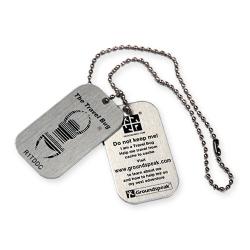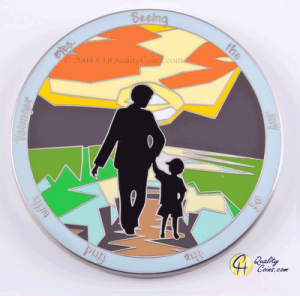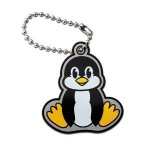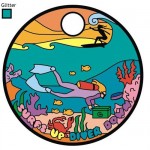A Guide To Geocaching Trackables
Keeping on with the trackables topic, I thought it would be nice to revisit some of the information about trackables in general. Here’s some information taken from our own guide.
—
If you have been caching for any length of time, then undoubtedly you have encountered some form of trackable item within the bounds of a geocache container. If you haven’t, then you will at some point. In the paragraphs that follow, you’ll read all about the various kinds of trackables, including geocoins, travel bugs, and several others. You’ll also find out the jist on what makes these different than typical “swag” you find in caches.
What is a “trackable”? How is it different than a tradeable?
When you find a normal sized geocache container, many times you will find little items that can be used for trade. The general rule is if you take something, give something. Whether it be pins, cards, toys, or whatever, the idea of trading within caches has been a fundamental concept since caching began.
However, trackables are NOT the same as tradeables. In fact, many newcomers to the sport often mis-identify trackables as something they can keep and therefore the owners of these unique moving items end up losing what they sent out.
A “trackable” item refers to the fact that the item in question has a unique tracking number on it. This number distinguishes it from all of the other “trackables” that exist in the world. In the same way that Fedex or UPS assign a tracking number to your package, a tracking number is assigned to “something” so that people can track what happens to that particular object.
As a general rule of thumb, the “something” is typically one of two types of trackables: Travel bugs and geocoins. Although there are variations on these and there are other types of trackables (discussed later), travel bugs and geocoins are the most common moving objects within the world of geocaching.
Travel Bugs

A travel bug is perhaps the most common of all trackable items within the world of geocaching. A travel bug is merely a set of “dog tags” that are attached to virtually any object you can imagine. From toy cars, to stuffed animals, to mugs, to even a lawn gnome, travel bugs come in all shapes and sizes.
On the tag there is usually a “bug” bar code with a a 6 digit tracking code underneath. This code can be typed into geocaching.com and the official page for that specific bug will be displayed.
The bug pages contain information about who owns the bug, where it came from, what it’s current mission is, the history of where it has travelled, and sometimes pictures of where the bug has been.
The same kind of information is displayed whether the trackable is a bug, a geocoin, or other type of traveler that has received a tracking code from Groundspeak (the owners of geocaching.com.
Many online (and brick and mortar shops) sell travel bug dog tags with the activation codes. Once you purchase a set of tags, you can then activate the tags online, and then attach them to whatever you wish, then release the item into the wild (drop it in a cache somewhere). Tags always come in pairs as the owner keeps a set while the other set is attached to the item being set free.
In most cases, the “mission” of travel bugs is to, well, travel. The general rule of thumb is that no travel bug, or any trackable for that matter, wants to sit in a cache. They want to move. Some have specific missions like getting to a particular city or visit certain historical sites, but all bugs are meant to be moved.
The one thing a bug is NOT meant for is to be kept as a personal keepsake from a cache. They are NOT swag and are in fact the property of someone else who has sent it out to move from cache to cache.
There are some variations on the travel bug theme. You can now buy bumper stickers or “clings” that show the bug bar code and a trackable number. These get attached to vehicles and people can use the tracking number to learn more about it. These types of bugs are usually the focus of “discovering” (covered later).
Geocoins

Much like travel bugs, geocoins are also trackable and go from cache to cache. They follow all of the same rules and guidelines as any other trackable item, but these are typically a metal coin of some kind.
Many coins are round (like the sample shown) but a lot of the coins are unusually shaped such as triangles, guitars, animals, and pretty much anything else you can imagine. They all however still have the look and feel of a coin. They have smooth surfaces with etched writing on them and many are in multiple colors.
Geocoins can be purchased through many various retailers but like regular coin collecting, some have more value than others depending on what the coin was created for.
Another aspect that differentiates geocoins from other trackables is that typically many of the same coin are produced for a specific person/group/event but each individual coin contains it’s own tracking number. For example, this past winter (2010), the Fredericton area geocachers had a geocoin minted that celebrated their winter hiding challenge. 150 coins were made all of which look identical, with the exception of the tracking code. The code is unique to each specific coin so if two people have the same coin, they both can release them and track their journey independent of one another.
Another huge aspect of geocoins is the “discovery” of coins. For every geocoin (and travel bug) that is registered on geocaching.com, you have the ability to “discover” that coin. Discovering of a coin or bug is not the same picking it up and taking it to another cache. Discovering is simply a means to say that you “saw” the coin/bug and wanted to make note of it. In some cases, people bring their coin collections to events to show them to other cachers. Others will write down the tracking numbers of coins they think are interesting, and then “discover” them online. This then records the fact that they saw that coin in their profile for future viewing.
Since most geocoins registered on geocaching.com have their own unique icon, many people like to discover as many coins as they can so that they will have many different icons on their profile. At larger events, there are tables of people with books filled with geocoins, and people writing down the codes of every one they see.
Cachekinz

Similar to Webkinz, these trackable items do not come with dog tags but the tracking code is printed directly on them. Inspired by the similar Webkinz series, this crossover into geocaching has allowed a new type of trackable to be seen out in the world of geocaching.
Like bugs and coins, they can be logged and moved, or simply discovered.
Since this is a relatively new type of trackable, there are far fewer of these out in the wild than there are coins and bugs but they are growing in numbers.
Cachekinz also share the same trait that geocoins do in that each type of Cachkinz has it’s own unique icon.
Pathtags & Other Non-Groundspeak Trackables

In the world of geocaching, most trackable items receive their trackable code from Groundspeak (GSP), the owners of geocaching.com. Since geocaches are logged on their site, by having them issue the tracking codes, it makes it much easier to “track” what items are out in the wild, information about them, and where they can be found. However GSP has very specific guidelines (and costs) associated with using tracking numbers issued by them. As a result of this, some people choose to release trackables using codes not issued by GSP. These items can still be tracked, but their information is not linked to your geocaching.com account, and cannot be viewed on the geocaching website.
From time to time you may pick up an item in a cache and attempt to log it on the official geocaching website and find that it does not exist. If you look a little closer at the item, you will likely find that it is registered with a different tracking site. One such example are pathtags.
Pathtags are very much like geocoins in that they are a circular piece of metal that have the look and feel of a coin. They can be tracked on the pathtags.com website, but they are typically meant to serve as a trading or a signature item. These can often be found at mega events, and can be produced for a relatively low cost compared to coins.
Although there are several other producers of trackable items which utilize their own set of codes, most cachers prefer to log bugs and coins that can then be associated with their geocaching profile. Many want to be able to see what they have logged and discovered all from a single location. This is the largest reason why non-GSP trackable items have not grown in popularity.
Best Practices
To know what you should and should not do with trackables, here’s a quick list:
- Trackables, regardless of the type, should not be kept as personal property. They are not meant to be used for trade.
- Any time you remove a trackable from a cache, be sure to log it on the website so that the owner knows where their trackable is.
- When possible, try to move the trackable to a new location within a few weeks of when you picked it up.
- If you need to keep it longer, email the owner or log a note on the bug page to let them know what you are doing with it.
- Try to respect the wishes of the bug owner by doing your part to fulfill the mission (if any) of the bug.
- If you find a geocache that is supposed to contain a trackable but does not, you may want to make note of this on the cache page when you do your log.
- Remember that all bugs/coins that are in the wild are meant to move. Some cache owners seem to think you shouldn’t take a bug if you can’t replace it with another one. Remember that cache owners have no say in what a bug does. The bug owner does. Don’t let travel bugs get stuck in a cache just because an owner says they don’t think you should take it.
- Many TB Hotel owners put a policy on their cache saying you can only take as many bugs as you leave. This is a policy that can result in bugs being trapped in a cache for long periods of time. If you have the chance to move them along, do so. Cache owners have no control over how many bugs you take and if you are concerned, email the bug owners.
- When hosting an event, be sure to have a place where all bugs/coins can be dropped/picked up so that none go missing.
- If you want to release your geocoin into the wild, but are concerned about theft, try making a photocopy of both the front and back, and release that. It lets the coin move while allowing you to keep the original.
